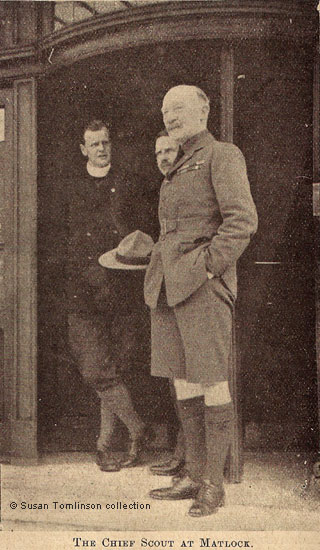On the Sunday morning many local scouts and their leaders marched
from Matlock to Holy Trinity Church for a special service and afterwards
they went into the grounds of the Royal Hotel where they were inspected
by the Chief Scout. Crowds gathered outside the grounds to watch;
they can be seen standing several rows deep in the hotel's gateway,
peering over the walls and some were allowed into the hotel's grounds.
Below is a lengthy extract describing the day's events from
an article that was published in the High Peak News the following
weekend[3]:
"...The troops represented were the 1st Matlock, Assistant-Scoutmaster
Mr. P. Bridge; 2nd Matlock Scoutmaster Mr. E. H. Bailey; Cromford
Assistant-Scoutmaster B. Parker; Lea and Holloway; also Beeley
and Baslow District Scoutmaster the Rev. J. Greenshields, and Assistant-Scoutmaster
Lieut. Lytle, of Bakewell.
These paraded at headquarters in the Dale Road before service,
and were headed for Matlock Bath by the Bugle Bands of Cromford
and Baslow, under Assistant-Scoutmaster B. Parker of Cromford.
There were present two King's Scouts, Assistant-Scoutmaster B.
Parker of Cromford (wounded in the Dardanelles), and Lieut. Lytle
of Bakewell (wounded in France).
The Rev. J. Holyoak, of Essex, was the special preacher at Matlock
Bath Parish Church. The first lesson was read by the Chief Scout
Sir Robert Baden-Powell, and the second by a visiting District
Commissioner. In charge of the Scouts was District Commissioner
F. C. Balguy and also District Scoutmaster the Rev. T. B. Browne,
of Darley Dale.
There were special hymns by the choir, the organist being Mr.
A. W. Bryan. The preacher's topic dealt with the seven loaves and
fishes, and he compared our Lord and Saviour as the greatest Chief
Scout the world has ever known. St. Andrew found the boy and he
compared him to the District Commissioners of the Boy Scout movement
looking out to help the boys.
The sermon lasted eleven minutes, and the preacher concluded by
saying the Scout must do his work for the honour of the State and
not for swank. The National Anthem concluded the service, which
was arranged by the vicar, the Rev. Wm. Askwith, M.A. Afterwards
there was a procession of the Boy Scouts to the Royal Hotel (the
headquarters of the Chief Scout), and here they formed up in double
file and the two bands played the General Salute. Afterwards the
Scouts stood "at attention".
They were next marched past Sir Robert Baden-Powell, and the Chief
Scout took the salute and inspected the lines with special attention
to practically every Scout.
He addressed a few words of encouragement to the Scouts and highly
complimented District Commissioner F. C. Balguy on the smart appearance
of the boys, also referring with pride to the way they had all
passed through their evolutions and drill on parade.
Later Mr. W. N. Statham, of Matlock, took an excellent photo of
the assembled officers and boys, with the Chief Scout as the centre
figure.
At the close of the inspection, the Boy Scouts gave three hearty
cheers for the General Baden-Powell. The event was a great success."
Although the conference delegates clearly enjoyed their stay in
Matlock Bath, they voted to go to Windermere the following year[2].









